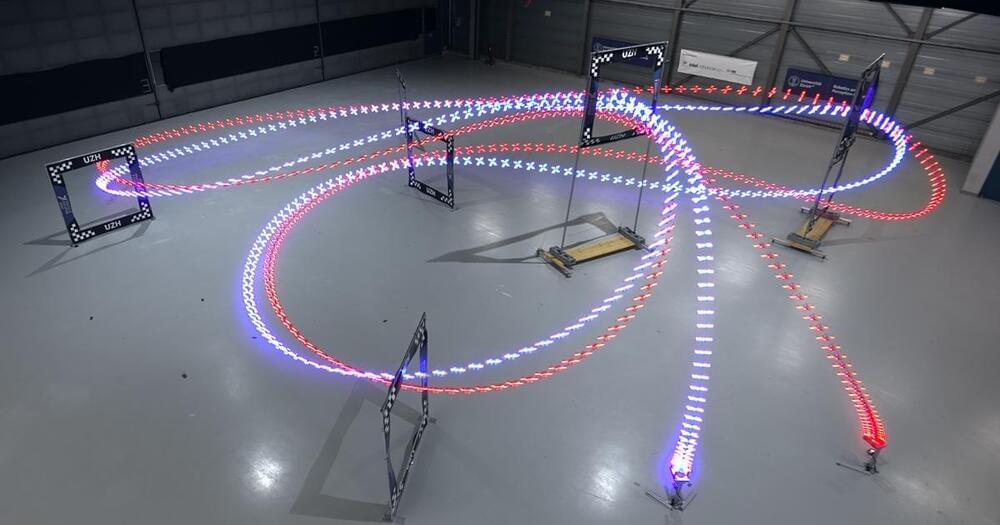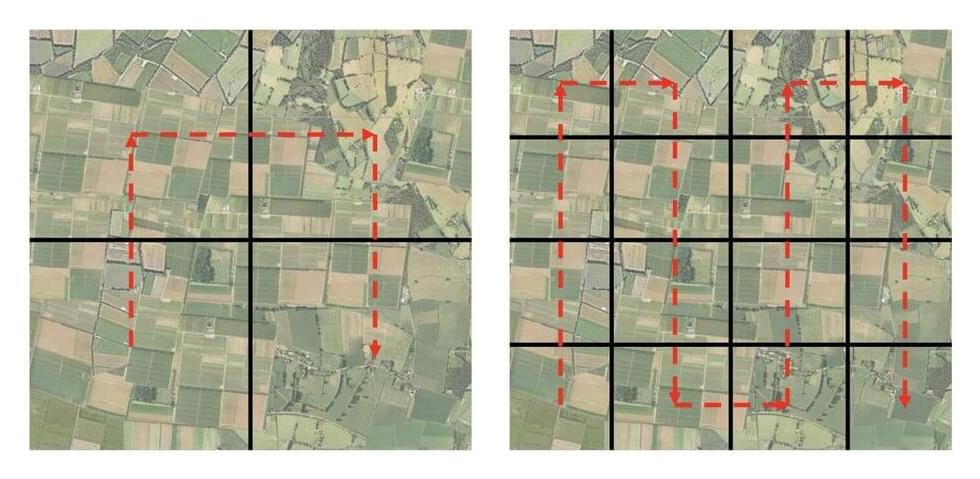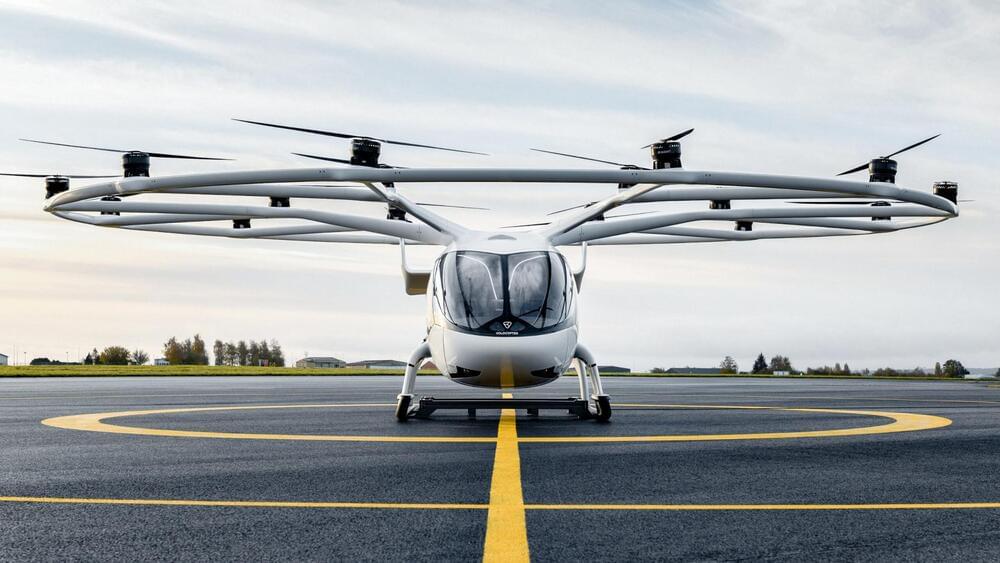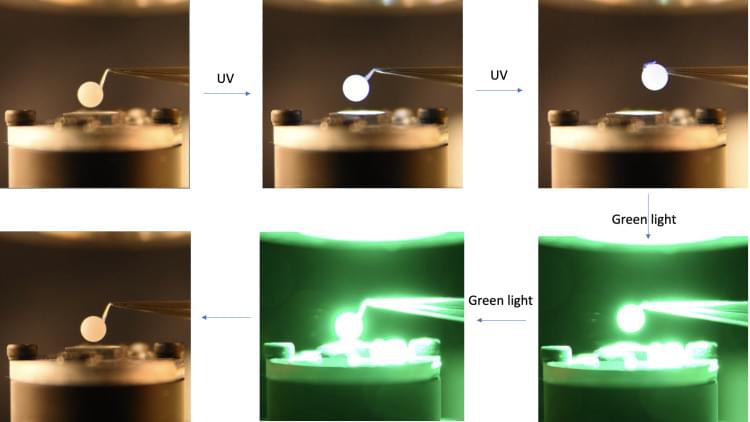The long-sought finding challenges scientists’ understanding of the strong nuclear force, and the AI that can beat human champions at drone racing.
Category: drones – Page 29

An AI pilot has beaten three champion drone racers at their own game
In what can only bode poorly for our species’ survival during the inevitable robot uprisings, an AI system has once again outperformed the people who trained it. This time, researchers at the University of Zurich in partnership with Intel, pitted their “Swift” AI piloting system against a trio of world champion drone racers — none of whom could best its top time.
Swift is the culmination of years of AI and machine learning research by the University of Zurich. In 2021, the team set an earlier iteration of the flight control algorithm that used a series of external cameras to validate its position in space in real-time, against amateur human pilots, all of whom were easily overmatched in every lap of every race during the test. That result was a milestone in its own right as, previously, self-guided drones relied on simplified physics models to continually calculate their optimum trajectory, which severely lowered their top speed.
This week’s result is another milestone, not just because the AI bested people whose job is to fly drones fast, but because it did so without the cumbersome external camera arrays= of its predecessor. The Swift system “reacts in real time to the data collected by an onboard camera, like the one used by human racers,” an UZH Zurich release reads. It uses an integrated inertial measurement unit to track acceleration and speed while an onboard neural network localizes its position in space using data from the front-facing cameras. All of that data is fed into a central control unit — itself a deep neural network — which crunches through the numbers and devises a shortest/fastest path around the track.

An energy-efficient object detection system for UAVs based on edge computing
Unmanned aerial vehicles (UAVs), commonly known as drones, are already used in countless settings to tackle real-world problems. These flying robotic systems can, among other things, help to monitor natural environments, detect fires or other environmental hazards, monitor cities and find survivors of natural disasters.
To tackle all of these missions effectively, UAVs should be able to reliably detect targets and objects of interest in their surroundings. Computer scientists have thus been trying to devise new computational techniques that could enable these capabilities, using deep learning or other approaches.
Researchers at Yunnan University and the Chinese Academy of Sciences recently introduced a new object-detection system based on edge computing. Their proposed system, introduced in the IEEE Internet of Things Journal, could provide UAVs with the ability to spot relevant objects and targets in their surroundings without significantly increasing their power-consumption.

EASA Charts Future of Drone, AAM Industry With Proposed Framework
The FAA made a big splash when it unveiled its Innovate28 plan for advanced air mobility (AAM) operations with electric vertical takeoff and landing (eVTOL) aircraft at scale by 2028. But while Innovate28 is just that—a plan—the agency’s friend across the Atlantic is already proposing hard requirements for AAM certification, operations, and maintenance.
The European Union Aviation Safety Agency (EASA) on Thursday shared its final opinion on rules and regulations for eVTOL air taxis, drones, and other emerging aircraft with the European Commission. Now, the ball is in the Commission’s court as it determines whether to accept EASA’s policy recommendations.
Opinion No 03/2023 lays out a comprehensive regulatory framework for safe operations of new aircraft types. It introduces requirements for piloted electric air taxi operations, flight crew licensing, air traffic management, and standardized European rules of the air (SERA). The proposal also suggests a criteria and process for the certification and maintenance of remotely piloted drones.
Swiss researchers invent drone-flying AI that tops champions
The AI won 15 of the 25 races against humans and led the fastest time on the track by more than half a second.
Researchers at the University of Zurich in Switzerland have developed an artificial intelligence (AI) system that can not only fly drones but also beat human counterparts who are champions, according to a press release published in Nature.
This is a major milestone for machine intelligence, which can lead to further development of other systems, such as self-driving vehicles and aircraft.
For the first time, AI dominates humanity’s best in a real-world sport
High-speed drone racing has just had a shocking “Deep Blue” moment, as an autonomous AI designed by University of Zurich researchers repeatedly forced three world champion-level pilots to eat its dust, showing uncanny precision in dynamic flight.
If you’ve ever watched a high-level drone race from the FPV perspective, you’ll know how much skill, speed, precision and dynamic control it takes. Like watching Formula One from the driver’s perspective, or on-board footage from the Isle of Man TT, it’s hard to imagine how a human brain can make calculations that quickly and respond to changing situations in real time. It’s incredibly impressive.
When Deep Blue stamped silicon’s dominance on the world of chess, and AlphaGo established AI’s dominance in the game of Go, these were strategic situations, in which a computer’s ability to analyze millions of past games and millions of potential moves and strategies gave them the edge.
Champion Drone Racers Beaten by a Pilot That Isn’t Even Human
The abilities of artificial intelligence (AI) systems are advancing at an astounding rate, nearing or bettering what humans can do in simulations and test environments.
Setting aside the ethical and environmental concerns around AI and those of autonomous drones for a minute, we can marvel at this latest feat: an AI-controlled drone system that beat three professional drone pilots in a series of head-to-head races, winning more often than not.
Swift is the name of the autonomous system, which outmaneuvered the world-champion human pilots in 15 of the 25 races, on a track full of sweeping turns and screeching pivots designed by a professional drone-racing pilot.
Israel enlists drones, AI and big data to farm for the future | AFP
As climate change and global population growth pose ever greater challenges for agriculture, Israeli technology offers a wealth of inventions and advanced tools to help farmers adapt.
Interested in licensing this video? Get in touch 👉 http://u.afp.com/wvnD
N.B.: AFP’s services and content are for professional use only.
How MIT researchers made tailsitter drones fly like acrobats
A tailsitter is a special kind of fixed-wing aircraft that sits on its tail when it is on the ground and then tilts horizontally for forward flight.
In the ever-evolving world of aerial technology, MIT’s researchers have given wings to the brilliance of aircraft design with their new algorithms for tailsitter drones. This breathtaking technology is enabling these aircraft to execute astounding acrobatics and challenging maneuvers, paving the way for futuristic applications in search-and-rescue, parcel delivery, and more.
MIT
Tailsitter Drones

CU Boulder researchers develop arrays of tiny crystals that deliver efficient wireless energy
Imagine a person on the ground guiding an airborne drone that harnesses its energy from a laser beam, eliminating the need for carrying a bulky onboard battery.
That is the vision of a group of CU Boulder scientists from the Hayward Research Group. In a new study, the Department of Chemical and Biological Engineering researchers have developed a novel and resilient photomechanical material that can transform light energy into mechanical work without heat or electricity, offering innovative possibilities for energy-efficient, wireless and remotely controlled systems. Its wide-ranging potential spans across diverse industries, including robotics, aerospace and biomedical devices.
In a new study published in Nature Materials, the Hayward Research Group has developed a novel and resilient photomechanical material that can transform light energy into mechanical work without heat or electricity. The photomechanical materials offer a promising alternative to electrically-wired actuators, with the potential to wirelessly control or power robots or vehicles, such as powering a drone with a laser beam instead of a bulky on-board battery.